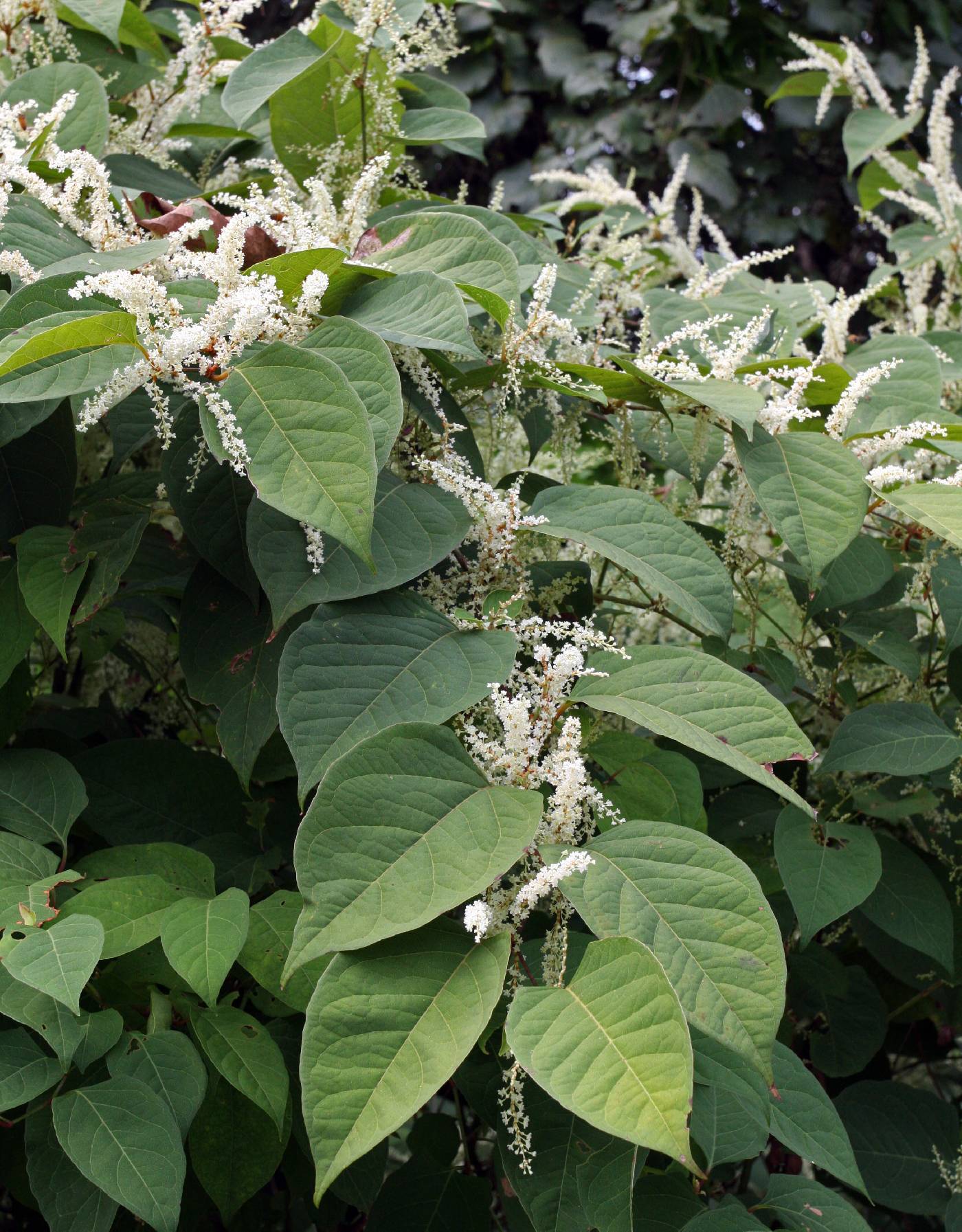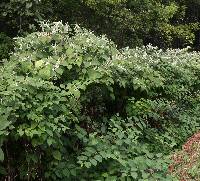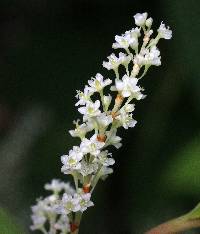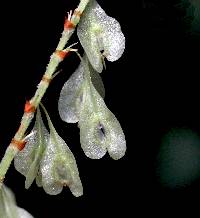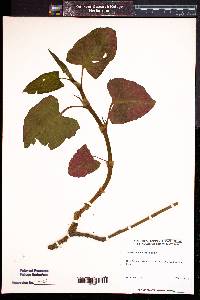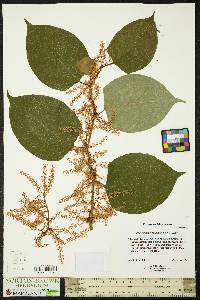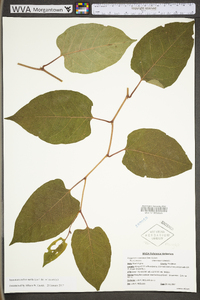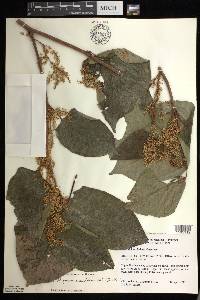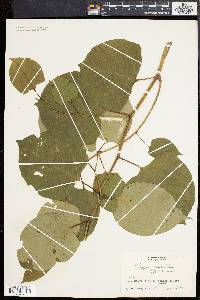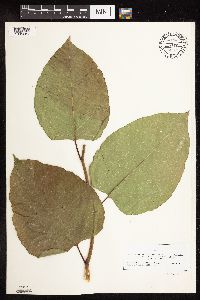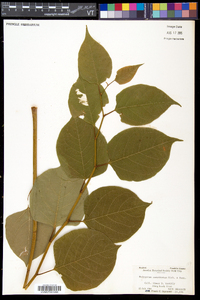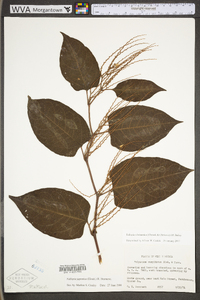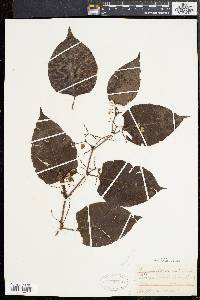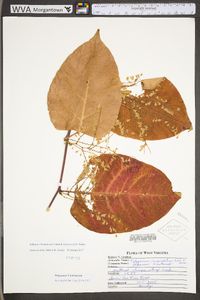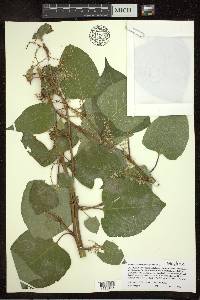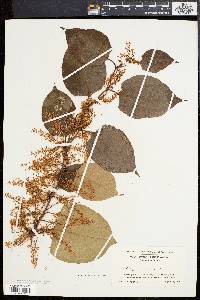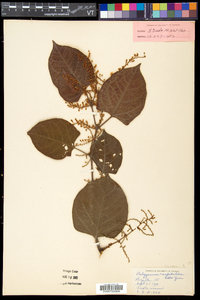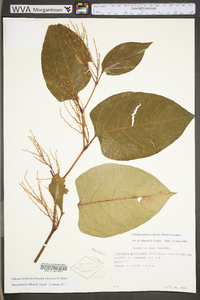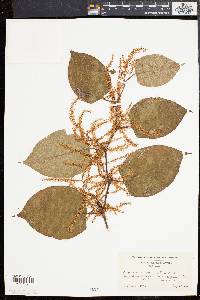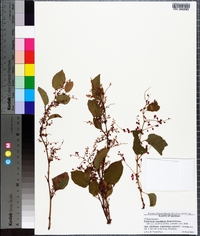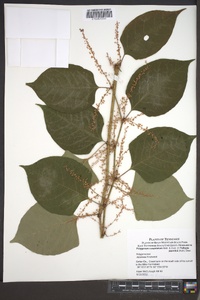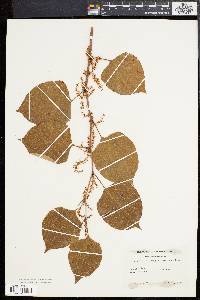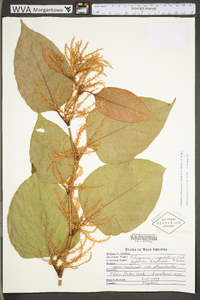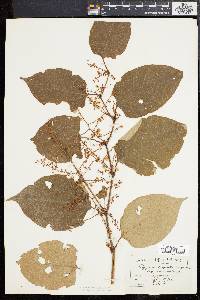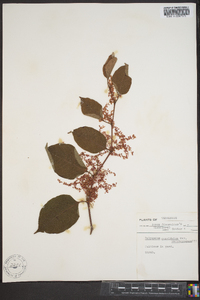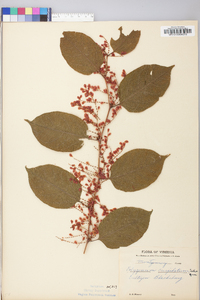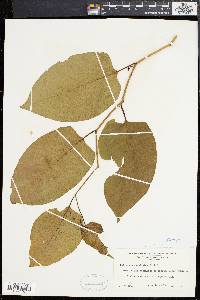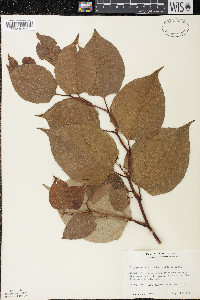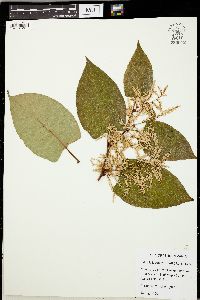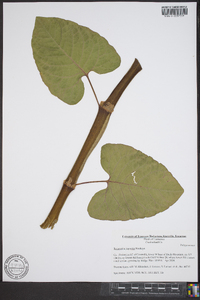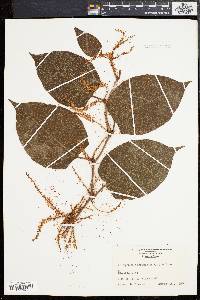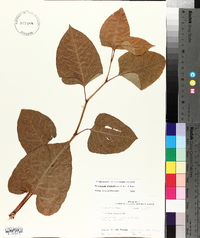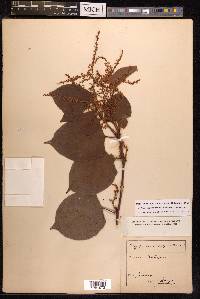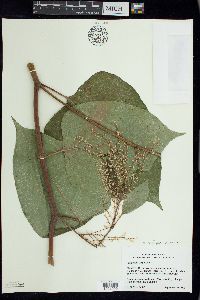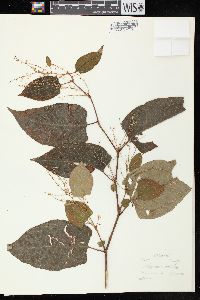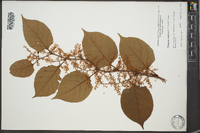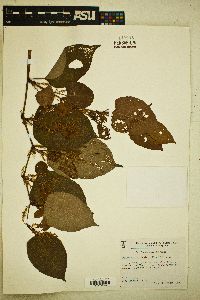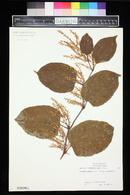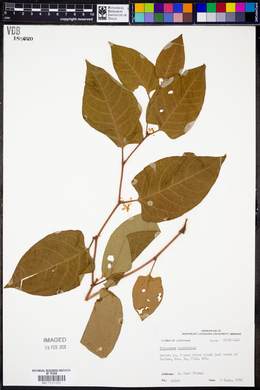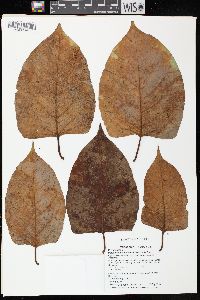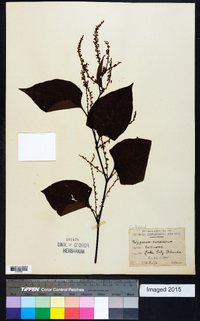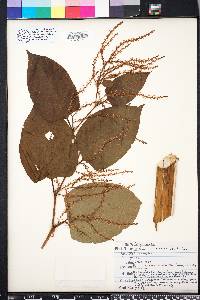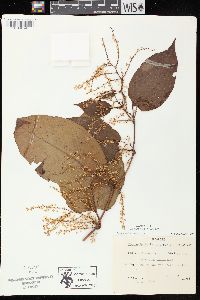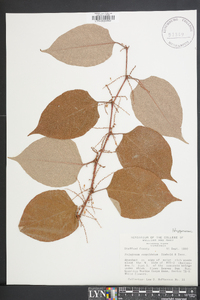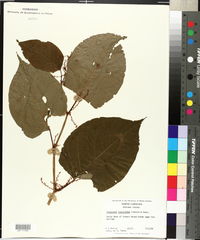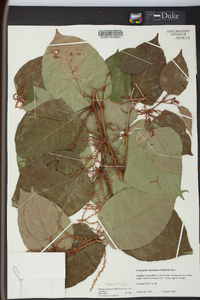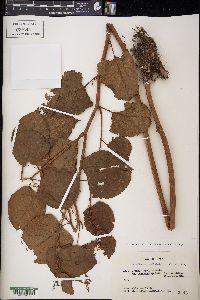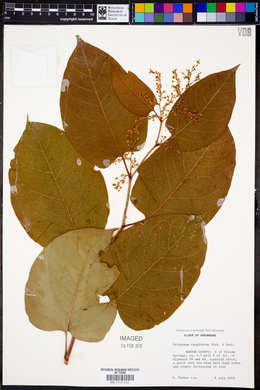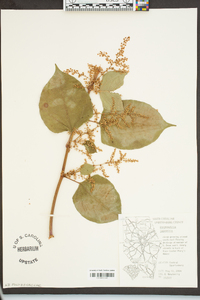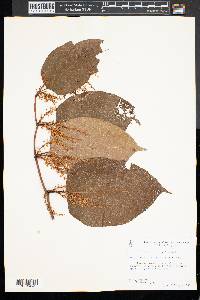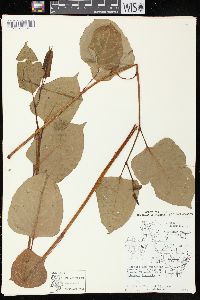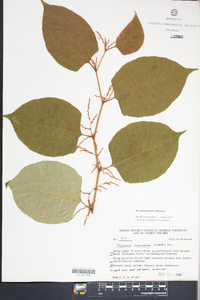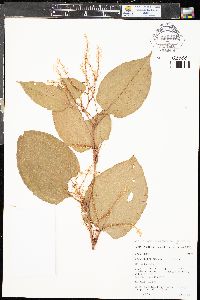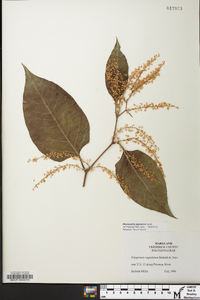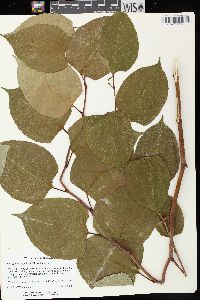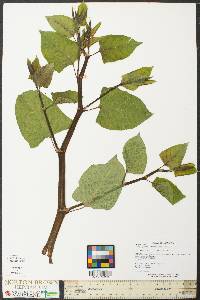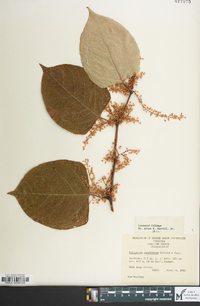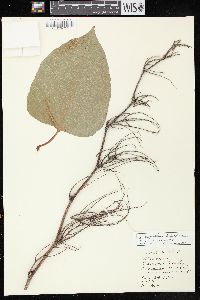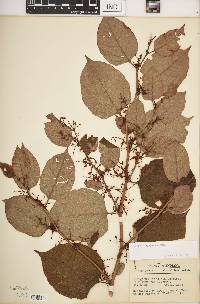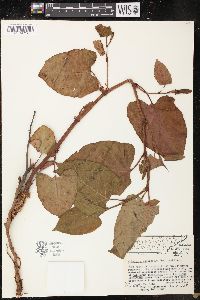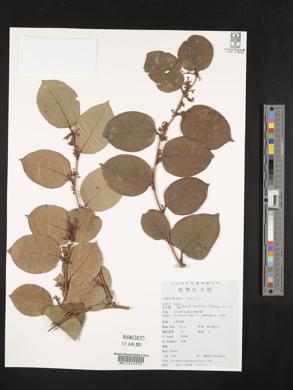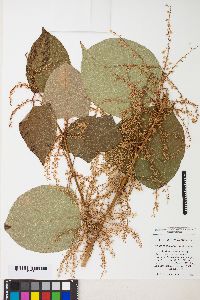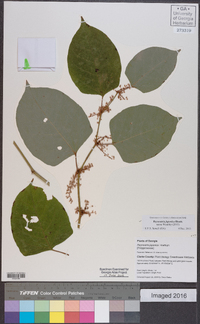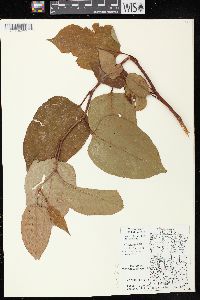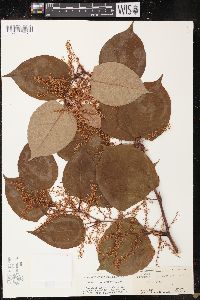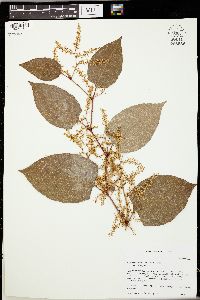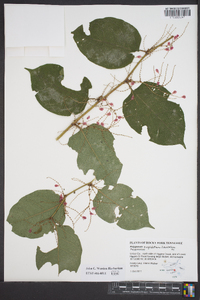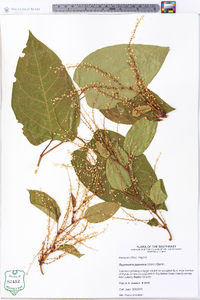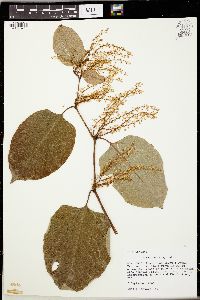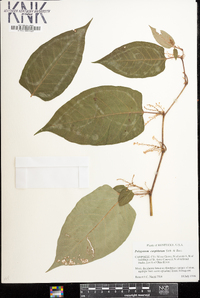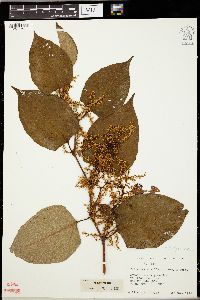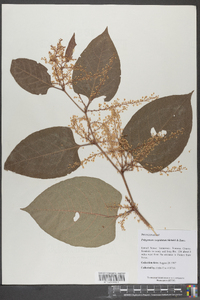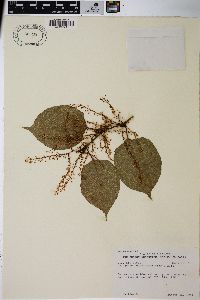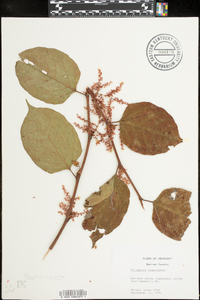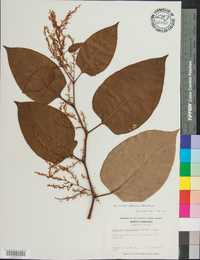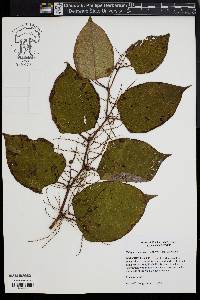Reynoutria japonica
|
|
|
|
Family: Polygonaceae
Japanese-Knotweed, more...Japanese knotweed
[Fallopia japonica (Houtt.) Ronse Decr., moreFallopia japonica japonica , Fallopia japonica var. compacta (Hook. f.) J.P. Bailey, Fallopia japonica var. japonica , Polygonum cuspidatum Siebold & Zucc., Polygonum cuspidatum var. compactum (Hook. f.) L.H. Bailey, Polygonum cuspidatum var. terminale (Honda) Ohwi, Polygonum japonicum Meisn., Polygonum reynoutria (Houtt.) Makino] |
Herbs, perennial, rhizomatous, 1.5-2(-3) m. Stems usually clustered, erect, profusely branched, herbaceous, stiff, glabrous, glaucous. Leaves: ocrea usually deciduous, brownish, cylindric, 4-6(-10) mm, margins oblique, face not fringed with reflexed hairs and slender bristles at base, otherwise glabrous or puberulent; petiole 1-3 cm, glabrous; blade ovate, 5-15 × 2-10 cm, base truncate to attenuate, margins entire, glabrous or scabrous to ciliate, apex abruptly cuspidate, abaxial face minutely dotted, glaucous, with hairs along veins unicellular, shorter than 0.1 mm, tips blunt, veins obscurely scabrous, adaxial face glabrous. Inflorescences terminal and axillary, erect or spreading, paniclelike or, sometimes, racemelike, 4-12 cm, axes puberulent; peduncle 0.1-2.5 cm or absent, puberulent. Pedicels ascending or spreading, articulated proximal to middle, 3-5 mm, glabrous. Flowers bisexual or pistillate, 3-8(-15) per ocreate fascicle; perianth accrescent in fruit, white or greenish white to pink, 4-6 mm including stipelike base, glabrous; tepals obovate to elliptic, apex obtuse to acute, outer 3 winged; stamens 8; filaments flattened proximally, glabrous; styles connate basally; stigmas fimbriate. Achenes included, dark brown, 2.3-3.6 × 1.4-1.9 mm, shiny, smooth; fruiting perianth glabrous, wings flat to undulate, 1.4-2 mm wide at maturity, decurrent on stipelike base nearly to articulation, margins entire. 2n = 44, 66, 88 (Korea). Flowering Aug-Sep. Disturbed sites, waste places; 0-1800 m; introduced; St. Pierre and Miquelon; B.C., Man., N.B., Nfld. and Labr. (Nfld.), N.S., Ont., P.E.I., Que.; Alaska, Ark., Calif., Colo., Conn., Del., D.C., Ga., Idaho, Ill., Ind., Iowa, Kans., Ky., La., Maine, Md., Mass., Mich., Minn., Miss., Mo., Mont., Nebr., N.H., N.J., N.Y., N.C., Ohio, Okla., Oreg., Pa., R.I., S.C., S.Dak., Tenn., Utah, Vt., Va., Wash., W.Va., Wis.; e Asia (China, Japan, Korea, Taiwan); introduced in Europe. Variety hachidyoensis (Makino) Yonekura & H. Ohashi and var. uzenensis (Honda) Yonekura & H. Ohashi are endemic to Japan and are distinguished by differences in leaf size and pubescence. A dwarf alpine form of Fallopia japonica found in Korea also is sometimes recognized as var. compacta (Houttuyn) J. P. Bailey. It is shorter (to 8 dm), has reddish perianths, and often is planted as a ground cover. Fallopia ×bohemica is a naturally occurring hybrid between var. japonica and F. sachalinensis. Fallopia japonica also hybridizes with F. baldschuanica.
Fallopia japonica is planted widely as a garden ornamental; it has a proclivity to escape and spread aggressively. Once established, plants can be difficult to eradicate because of their extensive, woody rhizomes. The species has been declared noxious in Alabama, California, Oregon, Vermont, and Washington.
Stout, rhizomatous perennial, 1-3 m, stems terete, becoming striate-ridged; lvs broadly ovate, 8-15 נ5-12 cm, abruptly acuminate, broadly truncate at base, the basal angles prominent; racemes numerous from the upper axils, often branched, forming a series of panicles 8-15 cm; fls functionally unisexual, the plants dioecious, perianth white or greenish-white; outer tep narrowly winged along the midrib; styles 3; achenes trigonous, 3 mm, invested by the enlarged perianth, the outer tep broadly winged; 2n=44, 88. Native of Japan, escaped from cult. and well established in our range. (Pleuropterus zuccarinii; Reynoutria japonica) Gleason, Henry A. & Cronquist, Arthur J. 1991. Manual of vascular plants of northeastern United States and adjacent Canada. lxxv + 910 pp. ©The New York Botanical Garden. All rights reserved. Used by permission. From Flora of Indiana (1940) by Charles C. Deam Indiana Coefficient of Conservatism: C = null, non-native Wetland Indicator Status: N/A |

